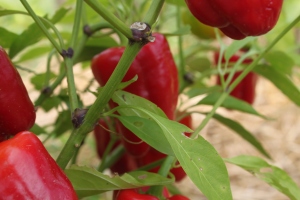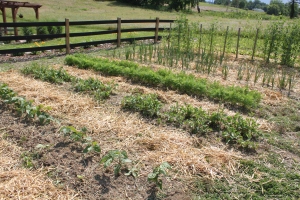When it comes to gardening, the truth is – it’s only expensive if you choose to make it that way. There are many ways to create, grow and harvest your own food without spending a bushel-full of cash.
With a little thought and ingenuity – you can nearly grow all of your own fresh food for free – with plenty left over for preserving by canning or freezing. With the ever-rising cost of fresh vegetables at the supermarket – if your goal is to eat healthier this year and with less preservatives in your diet – growing your own vegetables might be just what the doctor and your wallet ordered!
Preparing Your Growing Space: Keep It Simple – And Cheap!
Whether it’s buying or renting a rototiller to prepare the soil, or purchasing expensive wood or stone to build raised growing beds – if you let it – setting up your garden can be expensive and time-consuming. Here is some great news : you don’t have to do any of those to have a great looking – and heavy producing garden!
Although raised wooden or stone beds can be attractive – they are expensive to create. You can accomplish the same effect with simple raised rows using just the soil as your edge. Raised row beds are 8 to 12″ high planting areas built above ground using a combination of organic materials and top soil. We keep our rows at about 18″ wide, with a gentle taper on each side to help with drainage. The 18″ width allows proper root structure development for most plantings – while conserving the overall space of the garden and allowing enough room for the walking rows. See: Gardening with Simple Raised Rows and Raised Row Gardening Basics
As for that rototiller – it’s simply not needed. In fact, using one can often damage and compact the soil and lead to more weeds. You can accomplish everything and more with simple raised rows, and at the same time save on gas, maintenance and the cost of the machine! (See: How to Grow a Great Garden Without a Rototiller)
Don’t get me wrong – rototillers have a place – they are great for creating your first space from a grassy or overrun area – but beyond that – they simply are an unnecessary expense.
Fertilizers and Soil Amendments
If you really want to save money – GO ORGANIC and forget about spending all of your hard-earned cash on expensive fertilizers, soil additives and bug sprays – you simply won’t need them with healthy, organic soil.
When it comes to your soil, you can add all of the nutrition your soil will ever need by simply using compost! That means you can forget about having to buy those expensive bags of synthetic fertilizer or costly soil amendments that fill your local home and garden store shelves.
Compost is the king of healthy and active soil and the perfect soil booster for growing all of your favorite vegetables. We put a shovel-full in every planting hole in the spring, mulch around our plants with a 2″ layer compost, and even make a liquid fertilizer from it (see below). The best part – it’s free for the making! (See: The Basics Of Composting)
If you don’t have access for your own materials to compost, there are plenty available free for the taking right in your own neighborhood and community! Whether it be coffee grounds or vegetable peels from a local diner, leaves collected from the curb, or spent hops from a local brewery – you can find free sources of compost almost everywhere you look. (See: 8 ways to Find Free Compost Materials)
If you do want to apply a little natural boost of fertilizer during the growing season – you can use that compost to create your own free liquid compost tea – one of the best natural fertilizers around! (See: How To Make Compost Tea)
Bug Sprays and Chemicals
Not only is using commercial bug sprays expensive – they can be dangerous and harmful to you and your family when ingested – and with and organic garden – you won’t need them.

In most cases, a little bit of insect damage on leaves is not cause for concern – or full blown chemical warfare in your garden!
When you begin to grow organically and have healthy soil – one of the best side effects is that many of the pest and blight problems don’t ever appear. Bugs and disease will usually attack the weak – as in unhealthy plants and soil – and strong, healthy organic gardens put up great natural defenses against those problems.
Second, realize that a few bugs here and there won’t mean you need to instantly begin spraying everything in your garden. Most bug problems can be taken care of by simply removing them from plants – and a few blemishes here and there on your veggies is worth saving yourself and your garden from dangerous sprays. If you do see too much damage to your plants – try using a simple bug spray made from hot peppers and garlic to help control the area. (See: How to Battle Pests With Hot Pepper and Garlic Sprays)
Grow From Seed:
Last but not least – you can save BIG money by simply growing your own plants from seed. It can be expensive buying all of your tomato, pepper and vegetable plants from a greenhouse – not to mention you are at their mercy for the varieties you want to grow. By starting your own from seed – you can open up your garden to hundreds of new plants – all at a fraction of the cost. In addition – if you choose heirloom varieties – you can save your seed from year to year and grow for free! see: How to Easily Start Seeds Indoors and DIY Seed Starting Rack
If you really want to be thrifty – check with your local library or community center to see if your area has a free seed bank. Our community here in Licking County has a wonderful program available through the local library that allows for anyone to have access to free seeds for their garden.
So get out there and grow your own garden this year – and save a little cabbage!
Happy Gardening! Jim and Mary
If you would like to receive our DIY & Gardening Tips each week – be sure to sign up to follow the blog via email in the right hand column, “like” us on Facebook, or follow us on Twitter.





